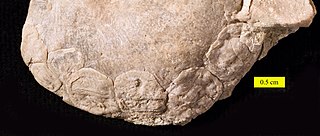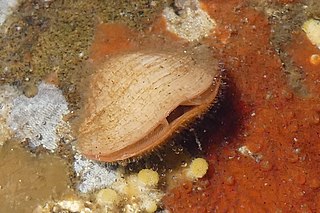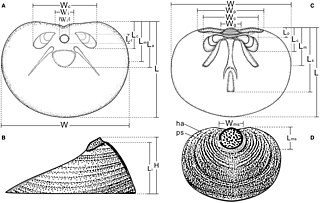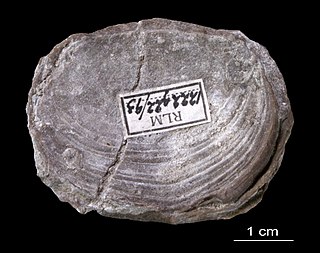
Craniata is a class of brachiopods originating in the Cambrian period and still extant today. It is the only class within the subphylum Craniiformea, one of three major subphyla of brachiopods alongside linguliforms and rhynchonelliforms. Craniata is divided into three orders: the extinct Craniopsida and Trimerellida, and the living Craniida, which provides most information on their biology. Living members of the class have shells which are composed of calcite, though some extinct forms my have aragonite shells. The shells are inarticulate and are usually rounded in outline. There is no pedicle, with the rear edge of the body cavity having the form of a smooth and flat wall perforated by the anus.
The Obolellata are a class of Rhynchonelliform brachiopods with two orders, Obolellida and Naukatida. They are essentially restricted to the lower-middle Cambrian.

The Craniidae are a family of brachiopods, commonly known as lamp shells. Although it belongs to a subdivision called the inarticulata which have shells where the mineral content consist of calcium phosphate, the Craniidae have shells that consist of calcium carbonate. Other special characteristics of this family are that no outgrowths are developed to form a hinge between both valves, nor is there any support for the lophophore. As adults, craniids either lived free on the ocean floor or, more commonly, were attached to a hard object with all or part of the ventral valve. In craniids, a pedicle is not known from any development stage.

Terebratula is a modern genus of brachiopods with a fossil record dating back to the Late Devonian. These brachiopods are stationary epifaunal suspension feeders and have a worldwide distribution.

Strophomenida is an extinct order of articulate brachiopods which lived from the lower Ordovician period to the mid Carboniferous period. Strophomenida is part of the extinct class Strophomenata, and was the largest known order of brachiopods, encompassing over 400 genera. Some of the largest and heaviest known brachiopod species belong to this class. Strophomenids were among the most diverse and abundant brachiopods during the Ordovician, but their diversity was strongly impacted at the Late Ordovician mass extinction. Survivors rediversified into new morphologies in the Silurian, only to be impacted once again at the Late Devonian mass extinction. However, they still survived till the mid Carboniferous.

Brachiopods, phylum Brachiopoda, are a phylum of trochozoan animals that have hard "valves" (shells) on the upper and lower surfaces, unlike the left and right arrangement in bivalve molluscs. Brachiopod valves are hinged at the rear end, while the front can be opened for feeding or closed for protection. Two major categories are traditionally recognized, articulate and inarticulate brachiopods. The word "articulate" is used to describe the tooth-and-groove structures of the valve-hinge which is present in the articulate group, and absent from the inarticulate group. This is the leading diagnostic skeletal feature, by which the two main groups can be readily distinguished as fossils. Articulate brachiopods have toothed hinges and simple, vertically-oriented opening and closing muscles. Conversely, inarticulate brachiopods have weak, untoothed hinges and a more complex system of vertical and oblique (diagonal) muscles used to keep the two valves aligned. In many brachiopods, a stalk-like pedicle projects from an opening near the hinge of one of the valves, known as the pedicle or ventral valve. The pedicle, when present, keeps the animal anchored to the seabed but clear of sediment which would obstruct the opening.

The origin of the brachiopods is uncertain; they either arose from reduction of a multi-plated tubular organism, or from the folding of a slug-like organism with a protective shell on either end. Since their Cambrian origin, the phylum rose to a Palaeozoic dominance, but dwindled during the Mesozoic.

Acrotretida is an extinct order of linguliform brachiopods in the class Lingulata. They lived from the Lower Cambrian to the Middle Devonian, with their peak diversity from the Middle Cambrian to the Ordovician. Acrotretida contains the sole superfamily Acrotretoidea.

Rhynchonelliformea is a major subphylum and clade of brachiopods. It is equivalent to the former class Articulata, which was used previously in brachiopod taxonomy. Articulate brachiopods have many anatomical differences relative to "inarticulate" brachiopods of the subphyla Linguliformea and Craniformea. Articulates have hard calcium carbonate shells with tongue-and-groove hinge articulations and separate sets of simple opening and closing muscles.

Crania is an extinct genus of brachiopods that lived during the Upper Cretaceous.
Mickwitziids are a Cambrian group of shelly fossils with originally phosphatic valves, belonging to the Brachiopod stem group, and exemplified by the genus Mickwitzia – the other genera are Heliomedusa and Setatella. The family Mickwitziidae is conceivably paraphyletic with respect to certain crown-group brachiopods.

Paterinata is an extinct class of linguliform brachiopods which lived from the Lower Cambrian (Tommotian) to Upper Ordovician (Ashgill). It contains the single order Paterinida and the subfamily Paterinoidea. Despite being some of the earliest brachiopods to appear in the fossil record, paterinides stayed as a relatively subdued and low-diversity group even as other brachiopods diversified later in the Cambrian and Ordovician.

Trimerellida is an extinct order of craniate brachiopods, containing the superfamily Trimerelloidea and the families Adensuidae, Trimerellidae, and Ussuniidae. Trimerellidae is a small but widespread family of warm-water brachiopods ranging from the mid Ordovician (Llandeilo) to late Silurian (Ludlow). Adensuidae and Ussuniidae are monogeneric families restricted to the mid to late Ordovician of Kazakhstan.
Craniopsidae is an extinct family of craniiform brachiopods which lived from the Lower Cambrian (Botomian) to the Lower Carboniferous (Tournaisian). It is the only family in the monotypic superfamily Craniopsoidea and the monotypic order Craniopsida.

Siphonotretida is an extinct order of linguliform brachiopods in the class Lingulata. The order is equivalent to the sole superfamily Siphonotretoidea, itself containing the sole family Siphonotretidae. They were most abundant in the Late Cambrian and Early Ordovician, and were traditionally considered to have gone extinct in the Upper Ordovician (Ashgill). However, they may have been present as early as Cambrian Stage 4, and as late as the Silurian (Ludlow). Siphonotretoids were originally placed as a superfamily of Acrotretida, before being raised to their own order.
Protorthida is an extinct order of Rhynchonellate brachiopods containing the taxa:
Orthoidea is a superfamily of brachiopods containing the families:
Productidina is a suborder of brachiopods containing the families:
Mesolobus is an extinct genus of brachiopod belonging to the order Productida and family Rugosochonetidae.
Schizophoria is an extinct genus of brachiopod belonging to the superfamily Enteletoidea. Specimens have been found in Devonian through Permian beds in North America, Australia, central and southeast Asia, and eastern Europe.










